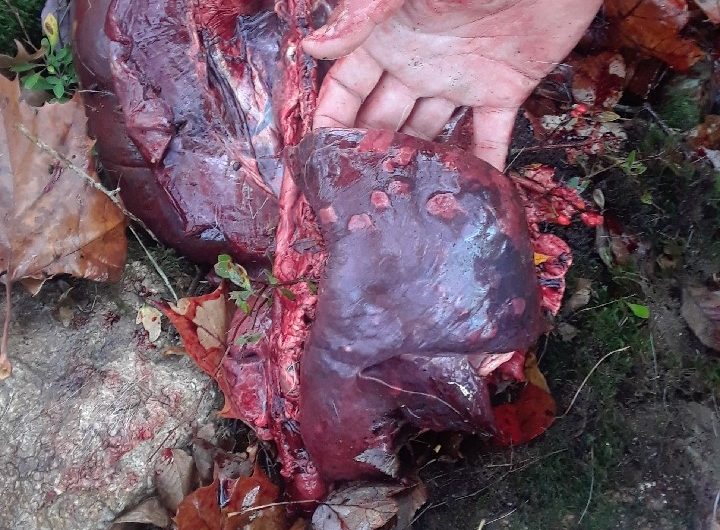In the latest report, our Foreign Correspondent relates palate preferences and unseen hitchhikers.
I hate liver.
But my parents love it. So whenever I get a deer they get some deer liver. I can’t stand the taste. That and being a biologist, I know the function of the liver – to filter all the yuck from our body. Colleagues in the wildlife veterinary profession have used the phrase “oil filter of the body.” Who wants to eat that? Hence, I don’t like scrapple either.
Wildlife can also be infected with various parasites. Deworming is not the norm for free-ranging critters. Deer livers are no exception. For them, it’s the liver fluke. I’ve never seen one in all my years of slicing deer livers from Maine to Georgia to Washington. But our desk anchor has gotten reports from curious hunters who have noted something amiss in their harvested deer’s liver.

It turns out that Europe is worried about liver flukes. And guess what? They came from the U.S.!
In the 1970s white-tailed deer and elk from the U.S. were transported to Turin, Italy. And they were infected with liver flukes. By 2015 the liver fluke was detected in Germany. This is why translocating can be a disaster. It’s not only the animal being moved. It’s all the parasites, bacteria, viruses, and prions they are carrying as well.
Giant liver flukes – Fascioloides magna – is also known as the American liver fluke.
The life cycle is fascinating. An adult liver fluke is about 2 inches long and when fully mature is a yellow-brown color. The yellow color comes from the eggs that fill the body. The eggs somehow make their way to the intestine where they are shed in the feces. They hatch in that warm moist pile of pooh into free-swimming larvae.
The feces are then fed upon by a snail and the fluke larvae “swim” through the foot of the snail. These larvae are not particular about the species of snail. There are several species that will do. Inside the snail, the larvae go through several generations of replication before leaving the humble snail as cercariae. Cercariae are also free-swimming and they “swim” onto vegetation and transform into dormant cysts waiting to be eaten by a deer. The cysts excyst after ingestion and make their way to the liver. The life cycle begins again.
Unfortunately European species of cervids are not the normal host of the American liver fluke. White-tailed deer tolerate infection without signs of disease. But what happens when a cyst-coated stem is eaten by a roe deer (Capreolus capreolus)? They travel through the body looking for the liver. When it comes upon, say, the lungs, it enters to find out whether it’s the liver. Roe deer lungs are not good at using the force to tell the fluke “this isn’t the organ you’re looking for; move along.” They do leave but not quietly. Some roe deer die from the fluke passing through the wrong organs.
If the fluke does happen to find the liver, it’s still not happy. In a white-tailed deer, the normal reaction is to wall off the intruder in fibrous capsules. These cysts are 1-2 inches long and usually contain 2 or more flukes. They are happy to live there pumping out eggs to do their part for species proliferation (liver flukes can live for 4-5 years). In a roe deer, the flukes just trash the liver, no little encapsulated condos.
How does this story end for roe deer and other susceptible species in Europe? So far not well. But nature might be working on a solution. The major histocompatibility complex (MHC) are immune system helpers. MHC molecules bind peptide fragments derived from pathogens be they bacteria, viruses, or liver flukes and display them on the cell surface for recognition by the appropriate T cells. Genetic research on MHC in roe deer suggests that eventually they may reach a truce with the new hitchhiker. The genetic make-up of the MHC in roe deer is complex in that it has some rare alleles that may help them adapt to the liver fluke like their North American cousins. Besides, killing its host is not beneficial to the liver fluke. It just wants a free place to shack up and make more flukes.
Whether this genetic adaptation will actually happen, only time will tell.
The next time you harvest a deer take a minute to check the liver. American liver flukes are primarily found in the Great Lakes region; the Gulf coast, lower Mississippi, and southern Atlantic seaboard; the northern Pacific coast; the Rocky Mountain trench; and northern Quebec. So unless you hunt in Erie you probably won’t see anything out of the ordinary but if you do, the Field Manual of Wildlife Diseases says not to worry. While “aesthetically unappealing,” livers damaged by flukes should be discarded but “consumption of venison from an infected deer poses no risk to humans.”
Duane Diefenbach, Chief Foreign Cervid Correspondent
Jeannine Fleegle, National Cervid News Desk Anchor
